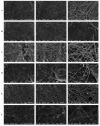Synergism between the Antidepressant Sertraline and Caspofungin as an Approach to Minimise the Virulence and Resistance in the Dermatophyte Trichophyton rubrum
- PMID: 36012803
- PMCID: PMC9409809
- DOI: 10.3390/jof8080815
Synergism between the Antidepressant Sertraline and Caspofungin as an Approach to Minimise the Virulence and Resistance in the Dermatophyte Trichophyton rubrum
Abstract
Trichophyton rubrum is responsible for several superficial human mycoses. Novel strategies aimed at controlling this pathogen are being investigated. The objective of this study was to evaluate the antifungal activity of the antidepressant sertraline (SRT), either alone or in combination with caspofungin (CASP). We calculated the minimum inhibitory concentrations of SRT and CASP against T. rubrum. Interactions between SRT and CASP were evaluated using a broth microdilution chequerboard. We assessed the differential expression of T. rubrum cultivated in the presence of SRT or combinations of SRT and CASP. We used MTT and violet crystal assays to compare the effect of SRT alone on T. rubrum biofilms with that of the synergistic combination of SRT and CASP. A human nail infection assay was performed. SRT alone, or in combination with CASP, exhibited antifungal activity against T. rubrum. SRT targets genes involved in the biosyntheses of cell wall and ergosterol. Furthermore, the metabolic activity of the T. rubrum biofilm and its biomass were affected by SRT and the combination of SRT and CASP. SRT alone, or in combination, shows potential as an approach to minimise resistance and reduce virulence.
Keywords: Trichophyton rubrum; antifungal resistance; caspofungin and biofilm; dermatophyte; sertraline; synergistic combinations.
Conflict of interest statement
The authors declare no conflict of interest.
Figures






Similar articles
-
The Antidepressant Sertraline Modulates Gene Expression and Alternative Splicing Events in the Dermatophyte Trichophyton rubrum: A Comprehensive Analysis.Genes (Basel). 2025 Jan 24;16(2):146. doi: 10.3390/genes16020146. Genes (Basel). 2025. PMID: 40004476 Free PMC article.
-
The Antidepressant Sertraline Affects Cell Signaling and Metabolism in Trichophyton rubrum.J Fungi (Basel). 2023 Feb 20;9(2):275. doi: 10.3390/jof9020275. J Fungi (Basel). 2023. PMID: 36836389 Free PMC article.
-
In Vitro Antifungal Activity of Sertraline and Synergistic Effects in Combination with Antifungal Drugs against Planktonic Forms and Biofilms of Clinical Trichosporon asahii Isolates.PLoS One. 2016 Dec 8;11(12):e0167903. doi: 10.1371/journal.pone.0167903. eCollection 2016. PLoS One. 2016. PMID: 27930704 Free PMC article.
-
Antifungal activity of geraniol and citronellol, two monoterpenes alcohols, against Trichophyton rubrum involves inhibition of ergosterol biosynthesis.Pharm Biol. 2015 Feb;53(2):228-34. doi: 10.3109/13880209.2014.913299. Epub 2014 Nov 21. Pharm Biol. 2015. PMID: 25414073
-
Trans-chalcone and quercetin down-regulate fatty acid synthase gene expression and reduce ergosterol content in the human pathogenic dermatophyte Trichophyton rubrum.BMC Complement Altern Med. 2013 Sep 17;13:229. doi: 10.1186/1472-6882-13-229. BMC Complement Altern Med. 2013. PMID: 24044691 Free PMC article.
Cited by
-
Alternative Splicing in Trichophyton rubrum Occurs in Efflux Pump Transcripts in Response to Antifungal Drugs.J Fungi (Basel). 2022 Aug 20;8(8):878. doi: 10.3390/jof8080878. J Fungi (Basel). 2022. PMID: 36012866 Free PMC article.
-
Dermatophytic Biofilms: Characteristics, Significance and Treatment Approaches.J Fungi (Basel). 2023 Feb 9;9(2):228. doi: 10.3390/jof9020228. J Fungi (Basel). 2023. PMID: 36836342 Free PMC article. Review.
-
The Antidepressant Sertraline Modulates Gene Expression and Alternative Splicing Events in the Dermatophyte Trichophyton rubrum: A Comprehensive Analysis.Genes (Basel). 2025 Jan 24;16(2):146. doi: 10.3390/genes16020146. Genes (Basel). 2025. PMID: 40004476 Free PMC article.
-
The Antidepressant Sertraline Affects Cell Signaling and Metabolism in Trichophyton rubrum.J Fungi (Basel). 2023 Feb 20;9(2):275. doi: 10.3390/jof9020275. J Fungi (Basel). 2023. PMID: 36836389 Free PMC article.
References
Grants and funding
LinkOut - more resources
Full Text Sources

